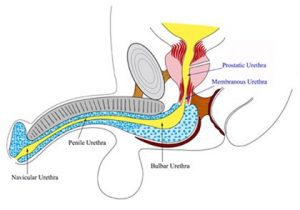
Males and females have a urethra, which is a thin tube-like structure whose primary function is to pass urine from the body. For men, the urethra also plays a vital role in ejaculation. Structurally, men have longer urethra as it covers the entire distance from the bladder to the penis. As such, urethral stricture a condition caused when a portion of the urethra becomes abnormally narrowed is more common in males. These strictures can either affect the first part of the urethra, also known as the posterior urethra or the final part that is known as the anterior urethra. The posterior urethra refers to the first one to two inches of the urethra that includes; the bladder neck, the prostatic urethra, the membranous urethra, and the external urinary sphincter. Strictures that occur anywhere along this part of the urethra are known as posterior strictures. On the other hand, the anterior urethra includes the meatus, the penile urethra, and the bulbar urethra. The narrowing of the urethra anywhere along this point is known as an anterior stricture.
Since urethral strictures can happen at any point in males, the realization of this condition is primarily through irregularities or difficulties while urinating. This is manifested by a slow, prolonged urinary stream and a feeling of a bladder that has not been completely emptied. For most males, this is often accompanied by abdominal pain, which is what often pushes them to seek medical attention. Nonetheless, it is critical to be aware that these symptoms are similar to other conditions, and the only way to rule out any other diseases is through a diagnosis.
The diagnosis for urethral stricture
It is only a professional urologist who has the expertise to perform the diagnosis for urethral stricture and not a general practitioner. While it is only natural to seek medical advice from your doctor, these professionals will always make a point to refer you to these specialists. Most importantly, problems with the urinary tract system must always be addressed by seasoned urologists. For the diagnosis of urethral stricture, a urologist will perform a test known as cystoscopy. The aim of this test is to confirm whether you have the condition, and this is then followed by X-ray imaging. This assists in determining the exact length, location, and severity of the urethral stricture.
The worry on what is urethral stricture is often accompanied by the need to have the condition cured for men who have undergone a professional diagnosis. Besides the difficulty with urination, left untreated urethral stricture leads to other complications if left untreated. These conditions include kidney failure, bladder damage, and prostatitis, which can be avoided by seeking timely professional care. Luckily, there are a variety of treatment options that seasoned urologists have used over the years and have proven to be highly effective.
What is the best treatment for urethral stricture?
While most urologists will quickly tell a patient that they need to have internal urethrotomy or dilation, seasoned specialists will not jump into conclusions. Instead, they will rely on the diagnosis to have exact details of the disease that they will use to discuss treatment options. The primary guiding factor to the most suitable treatment option is the length of the urethral stricture that is realized after a retrograde urethrogram or RUG. This is more than a scope test but a proper urethral X-ray imaging that provides an accurate view of the length and location of the stricture. Primarily, the only time that urethral X-ray imaging is not useful is for men with severed urethra from a pelvic bone fracture.
When it comes to the treatment of urethral stricture, urologists prefer less invasive approaches that will provide long-term results. This is why many people consider dilation and urethrotomy to be the standard treatment procedure. However, these treatment options are only favorable options when the stricture is very short, and there is a need for quick improvement of the condition. Seasoned urologists tend to move more towards open urethral reconstruction that is loved for its high success rates. Correctly performed, this procedure has one of the highest cure rates and is often the go-to option for treating recurrent strictures. The best part is that specialists who have expertise in handling this procedure use dedicated instruments and instruments. This goes a long way in ensuring low risks of complications and the long-term cure of these conditions.

